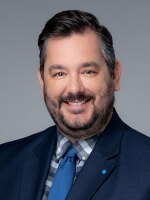An estimated 7 million teenagers nationwide are involved in high school sports. And whether it’s football, basketball, or even cheerleading, injuries happen. But there are no universal requirements regarding medical personnel or athletic trainers at games and practices.
A new program in San Diego is trying to fill the gap.
In May 2009, two weeks before graduation, Tommy Mallon was playing in his final lacrosse game at Santa Fe Christian High School in Solana Beach.
At one point, Mallon and an opposing player went for a ground ball. They smashed into each other, and Mallon went down.
Luckily, the school had an athletic trainer on the sidelines. As she kneeled over him, Mallon told her he couldn’t feel the back of his neck. She had someone call 911.
"I had broken my neck in three places," Mallon said. "So, if I had gotten up, I could have severed my spinal cord. All my doctors either told me that I would have died, or at least been a quadriplegic."
The National Athletic Trainers Association says every year, sports injuries put about 30,000 high school athletes in the hospital. Even so, only about four out of ten high schools nationwide have an athletic trainer.
That’s the impetus for a new program called Athletes Saving Athletes.
At Torrey Pines High School, an instructor barks commands to a roomful of student athletes. In this segment of the Athletes Saving Athletes program, teens are learning how to perform CPR.
Tommy Mallon’s mom, Beth, launched the program in January.
"We’re not trying to train athletes to take the position of an athletic trainer," Beth Mallon pointed out. "But we’re training them to do is what an emergency situation looks like, and what you might be able to do as an athlete."
That includes teaching students how to recognize some of the signs of heat stroke. They also learn the importance of not moving an athlete that may have suffered a back or spinal injury.
"They learn plays, they’re in AP courses, they’re smart kids. They’ve just never been given this knowledge," Mallon said. "They just assume that there’s a supervising adult out there that’s gonna take care of them, and that’s not always the case."
He said each school district sets its own policy.
"There’s not a standard for medical personnel throughout the state," Schneipp explained. "And to be honest, I think the reason, is there are different levels of financial ability to pay for those kind of people in different school districts."
Schniepp said ideally, all high schools should have an athletic trainer on staff. But given the financial challenges districts face, it’s not practical.
"And when you’re havin’ to make decisions of a trainer for a 1:30 practice, or a fulltime teacher to help students learn how to read, it’s a tough call for people who make those decisions," Schniepp said.
Dr. Shawn Evans sees a lot of high school sports injuries in his emergency room at Scripps Hospital in La Jolla.
Dr. Evans believes it makes sense to train young athletes to be first responders.
"You can get a group of five-year-olds, kindergarteners, to understand the use of an A.E.D. and save someone’s life in 10 to 15 minutes of training. We can certainly do it with high school seniors," Evans argued. "And ultimately, around concussion awareness, that’s a fundamental skill I’d love for everyone in the public to have. Sadly enough, when most people get that knowledge, it’s after they’ve had the concussion. So why not before?"
Beth Mallon said that’s the philosophy behind the Athletes Saving Athletes program.
"You know, we spend so much money in the best equipment, the best helmet, the private lessons, but we spend very little in proper medical care, and who’s on the sidelines taking care of your athlete when a catastrophic injury occurs.
Mallon has taken her program to three local high schools so far this year. She’ll train athletes at four more schools in the county over the next few months.







